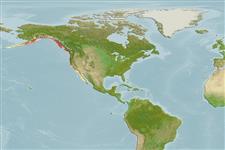Common names from other countries
Classification / Names / Names
ชื่อสามัญ | ชื่อพ้อง | Catalog of Fishes (gen., sp.) | ITIS | CoL | WoRMS
Environment: milieu / climate zone / depth range / distribution range
นิเวศวิทยา
; ระดับความลึก 0 - 40 m (Ref. 290). Temperate
Eastern Pacific.
Length at first maturity / ขนาด / น้ำหนัก / Age
Maturity: Lm ? range ? - ? cm Max length : 13.0 cm TL เพศผู้/กระเทย; (Ref. 290)
Girdle: Black leathery covering almost the entire dorsal area. Dorsal ridge area of each valve: small portion; left exposed (Ref. 296).
Surf-zone to 40 m. Usually found on stony or rocky bottoms (Ref. 290); in the middle intertidal zone from Alaska to Point Conception; North of Santa Barbara; also on rocky shore with heavy wave action (Ref. 312). Herbivorous, feeding primarily on red and green algae and benthic diatoms (Ref. 312).
Life cycle and mating behavior
วัยเจริญพันธุ์ | การสืบพันธุ์ | การวางไข่ | เซลสืบพันธ์ของเพศเมีย(ไข่) | ความดกของไข่ | ตัวอ่อน
Members of the class Polyplacophora are mostly gonochoric. Life cycle: Eggs hatch into lecitotrophic planktonic trocophore larvae (no veliger stage) which later metamorphose and settle on the bottom as young adults.
Burghardt, G. and L. Burghardt. 2006. (Ref. 296)
IUCN Red List Status (Ref. 130435)
CITES status (Ref. 108899)
Not Evaluated
Not Evaluated
Human uses
| FishSource |
เครื่องมือ
ข้อมูลเพิ่มเติม
Age/SizeการเจริญเติบโตLength-weightLength-lengthสัณฐานวิทยาตัวอ่อนอุดมสมบรูณ์
แหล่งที่มาจากอินเตอร์เน็ต
Estimates based on models
Preferred temperature
(Ref.
115969): 6.1 - 10.9, mean 8.9 (based on 94 cells).
Vulnerability
Low vulnerability (10 of 100).
Price category
Unknown.
